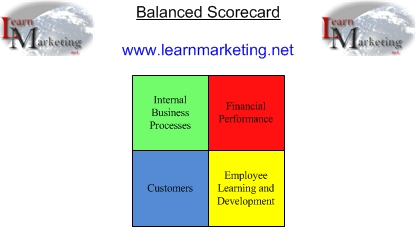Balanced Scorecard
Performance measures have traditionally focused on how much (quantitative data) of something has been achieved but not how it was achieved. This can create problems as quantitative performance does not take quality into account. When attention is focused solely on what is achieved and not how it is achieved the company's reputation may be affected, staff morale may decline and it may even affect the long term future of the organisation. The balanced score card attempts to rectify this by reviewing both qualitative and quantitative results.

History
It is believed that the balanced scorecard was created in 1987 by Art Schneiderman, a consultant for Analog Devices but its adoption didn't occur until 1992 when Dr. Robert S Kaplan and Dr. David P Norton published their paper on balanced scorecards.
Balanced Scorecard Sections
The balanced scorecard is split into four areas; Finance, internal business processes, customers and employees. The four balanced scorecard areas are incorporated into the organisation's strategy and performance measures. Each area is said to be interdependent as success or failure in one area may affect another area.
This section of the balanced scorecard will review financial performance and activity ratios. The firm will look at financial documents such as profit and loss accounts and balance sheets to see how well the firm is doing financially. The may review cashflow so that they can see the source for money coming into the firm and what the firm is spending money on. An important analysis will be the return made on money invested in the business (return on capital employed ratios). The financial performance section of the scorecard may seem like a quantitative area because it is looking at "how much" is made/sold/bought etc. but it can also be qualitative by reviewing financial efficiency and through highlighting risk areas such as the level of debt (gearing) and business investments..
This section of the balanced scorecard measures the effectiveness of the processes used by the business. Internal business processes should limit unnecessary and duplicate work. If possible they should be automated through technology and they should ensure that the business is following legal rules. The job of internal business processes is to safeguard the business and its assets. Therefore performance measures under this section will review business process efficiency, safeguards and compliance with legal rules and regulations.
As we know happy customers are big part of business success so this section of the balanced scorecard will assess customer satisfaction. Customer satisfaction can be tested through things like customer feedback questionnaires and mystery shopper results. The aim for this section of the scorecard is to view things from a customer's perspective.
This area of the balanced scorecard focuses on employees from employment induction through to employment termination. It may include employee skills, personal development plans, employee satisfaction results, and employee turnover. As well as an interview at recruitment stage employees may asked to participate in an exit interview before they leave the organisation. The exit interview aims to find out why the employee is leaving the organisation so that the feedback can be used to increase employee satisfaction and reduce employee turnover.



